Frontend Development Trends 2023
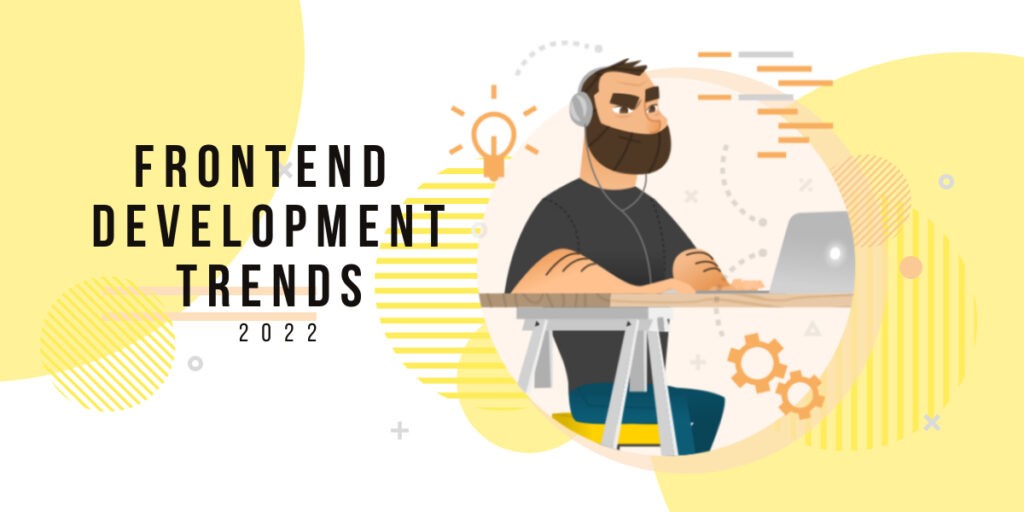
Today, a user is using a plethora of different devices and is really looking forward to the best user experience on them. If a site takes more than 2 seconds to load, half of the users will abandon it, and will never return. To enhance the user experience, speed, performance, and time-to-market, new technologies are growing and evolving. One area which has seen a tremendous transformation is frontend development. This article will help you understand the frontend development trends in 2022.
1. Headless Architecture
2. Component-based Development
3. Jamstack
4. Micro Frontend Architecture
5. Single Page Applications(SPA)
6. Progressive Web Apps(PWA)
1. Headless Architecture
Headless architecture is a client-side web application that does not have a connection with a server-side. The ‘head’ i.e. the frontend is detached from the body i.e the backend(content/server). The business logic and the functionality are available in the form of APIs. A specialized backend streamlines these APIs to a frontend channel respective to the user platform or channel.This architecture allows creation of multiple frontends in various formats using different technologies.
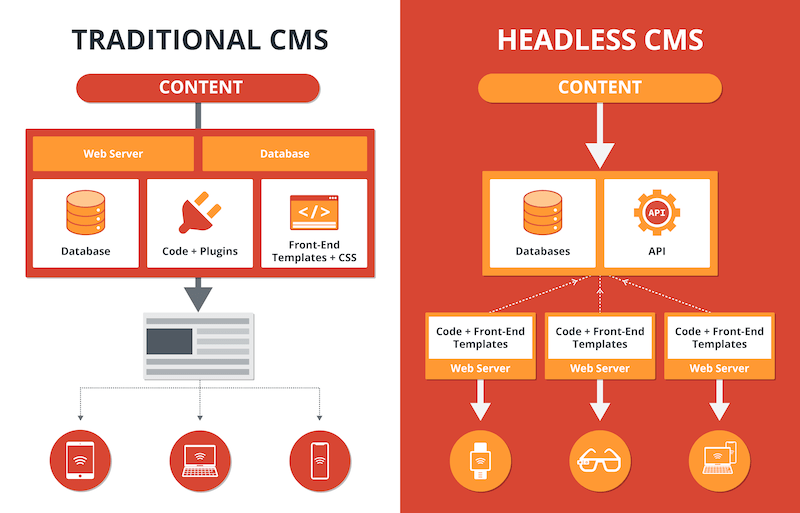
Example: Headless CMS where the content is managed by Content Management System, an interface, and RESTful or GraphQL API to deliver content wherever required.
So, what are some the advantages in using Headless CMS?
- Works on multiple channels or platforms: The same code or application can work on multiple devices or platforms with ease. This promotes reusability of code, reduces rework and effort of developers. For example for an e-commerce application, the modules(APIs) of cart, user profile, order placement can be reused on all channels easily.
- Flexible architecture: Headless architecture provides the freedom to developers to choose the frontend framework. This helps in building a frontend which is most suitable for the application.
- Richer user experience: Developers can get creative with the headless architecture by using the existing code, content or server. This provides them with the ability to provide great user experiences.
- Scalability: Headless architecture has the backend and frontend separate from each other. Hence, when you want to grow, it can be done easily without hampering the existing performance and functionality. This promotes the agile methodology since the frontend can be upgraded quickly and time-to-market is decreased considerably.
2. Component-based Development
Component-based development is an approach to software development that focuses on the design and development of reusable components.
These components can talk to each other using the interface between them. Therefore, they can be used anywhere without any limitations. Additionally, these components can be upgraded, tested, modified without causing any impact on other components.
Example: The commonly used components in an application can be location tracking through GPS, authentication using OTP etc. These components are coded once and saved as a module. Whoever wants to use these modules can access and use them in their code without rewriting them.
Advantages in using component-based development
- Faster delivery: The components are reusable hence there is no need to create everything from scratch. Developers can use the existing components(modules) and this helps in decreasing the delivery time considerably.
- Improved efficiency and quality: Components such as themes or widgets are standard or same across the whole application. So once defined, everyone is going to use the same theme or widget properties across applications. This improves the efficiency and quality of the application.
- Low maintenance cost: The component’s code is stored at a centralized location, where everyone has access to use it. If the components need to be upgraded or updated it can be done easily at one location. Whoever is using that component in their code will get an updated version automatically, without individual efforts. This results in lowering the maintenance cost of code updates.
Read in detail here about component-based architecture.
3. Jamstack
Jamstack(Javascript, API, and Markup) is a new standard architecture for websites to make them faster, secure and easy to scale-up.
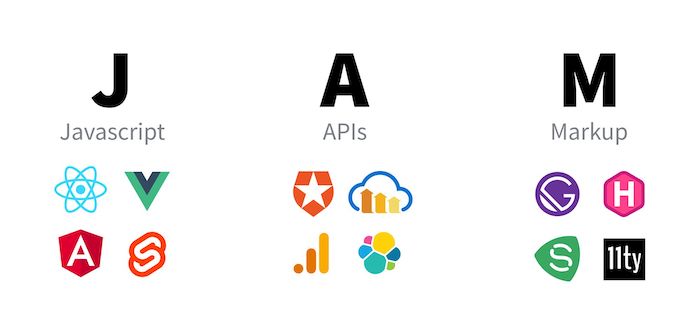
It works on the principles of decoupling and pre-rendering. Pre-rendering means that the whole frontend is prebuilt during the build process. These pre-built static pages are highly-optimized and can be directly rendered through a CDN(Content Delivery Network). Therefore, Jamstack is faster and more secure than the traditional web which uses databases and servers to deliver content.
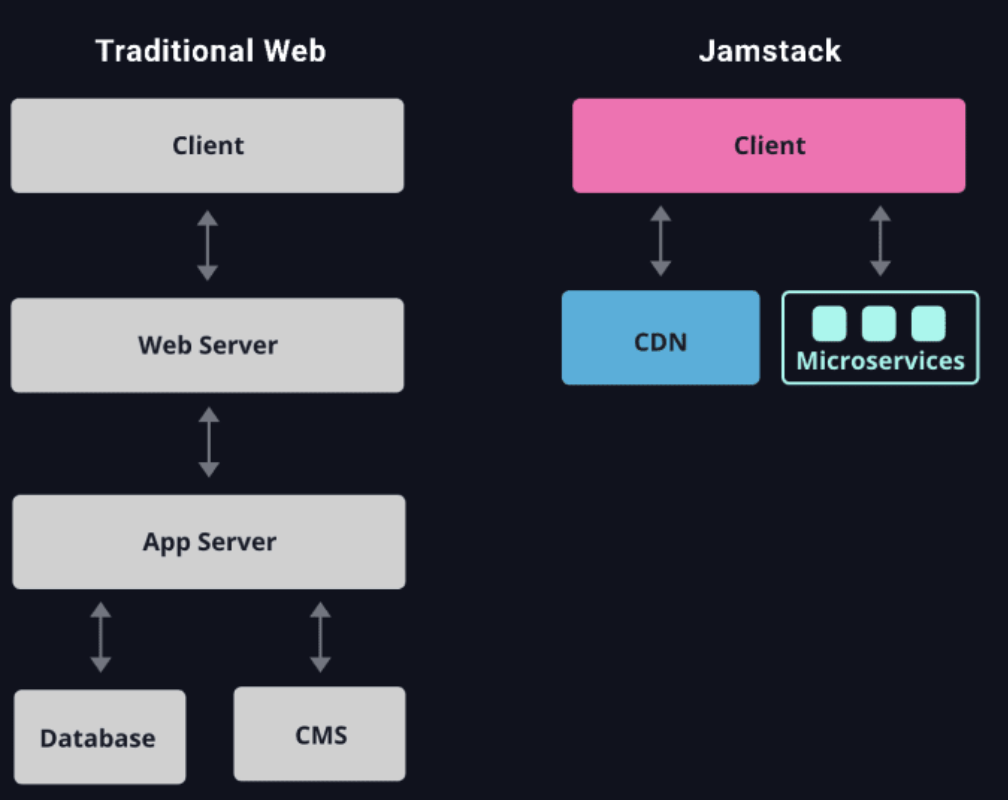
Advantages in using Jamstack
- Faster speed: Jamstack reduces the loading time because the pages are pre-generated at the build time. This ensures faster speed and great user experience.
- Low cost: Hosting static content involves less cost than that of dynamic or traditional web content. A site can be cached and served entirely from CDN, and a huge infrastructure is not required.
- Better security: There is no server associated for rendering purpose, and hence server security is not an issue here. The only security you need to take care of is permissions on private user content.
- Easy maintenance: Jamstack reduces the complexity associated with the hosting of the website, since they are static and pre-generated. There is no server associated for the rendering purpose and therefore there is no need to maintain the server.
- Supports portability: Jamstack websites are pre-generated and static. They can easily be hosted on a variety of hosts without any hassle. Hence, it supports portability of the website.
4. Micro Frontend Architecture
The micro frontend is being adopted as a solution to monolithic frontend development. It takes inspiration from microservices-powered backend software development. Similar to microservices, the monolithic front-end is divided into loosely coupled components. Then these independently deliverable front-end components are integrated to create a whole frontend application.
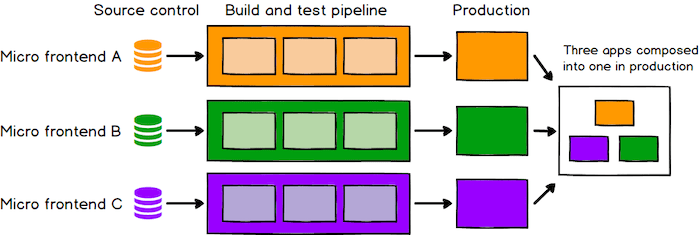
Advantages in using micro frontend
- Smaller codebase: Codebase is smaller and easily maintainable for these components.
- Promotes scalability: The micro frontend teams are decoupled, independent, and hence promote scalability in the organization.
- Decoupled architecture: Upgrade, change, and update is easier for smaller components without affecting others.
- Easier to maintain stability: Independent components help to keep the application stable. If there is any failure or upgrade only that particular component requires attention.
Read in detail about micro frontend development here.
5. Single Page Applications(SPA)
It is a web application implementation that works on loading a single web document.
It works inside a browser and does not require a reload during use, therefore there is no extra wait time. As we see in the diagram below, there is only one initial GET request in the SPA Lifecycle. Later there are AJAX and JSON calls to get and send data.
Mostly SPA uses Javascript, CSS, HTML as resources, and these are loaded only once during the application usage. Later, it is only the data that is sent to and from the server, and hence there is no page reload involved. It is the major reason why SPAs are fast and provide a better user experience. SPAs are easy to test on a Chrome browser using the Dev Tools of Google.
Advantages in using Single Page Applications (SPA)
- Faster loading time: Single Page Application loads only once at the initial request, later there is no load time involved. Therefore, SPA is faster than traditional websites where the page has to load for every request.
- Works on low network bandwidth: SPAs load only once therefore they use less bandwidth. Also, they have the capability to work on slow internet connection, therefore everyone can use them.
- Better user experience: SPAs provide the user experience at par with the mobile or desktop apps. The user need not wait for a page to load, because only content changes and the page reload never happens in Single page Applications.
- Promotes better features: It is easier to incorporate rich and advanced features to a SPA website when compared to a traditional website.
6. Progressive Web Apps(PWA)
They are built on the web(they are web apps) but they behave as if they are native applications. The features such as they are installable, available when offline, can use a camera or device features, push notifications, are similar to native apps. The Progressive Web Apps are developed using popular web technologies such as HTML, Javascript, CSS.
A PWA can be built using the below components:
- Web app manifest: Add it using JSON file to share important information with the browser about the app such as app icon, app name, background color, etc.
- Service Workers: Runs in the background of the app as an event-driven worker to bring the network and app in tandem.
- Application Shell: First thing a user sees is an application shell.
- HTTPS: Required for secure access to the app.
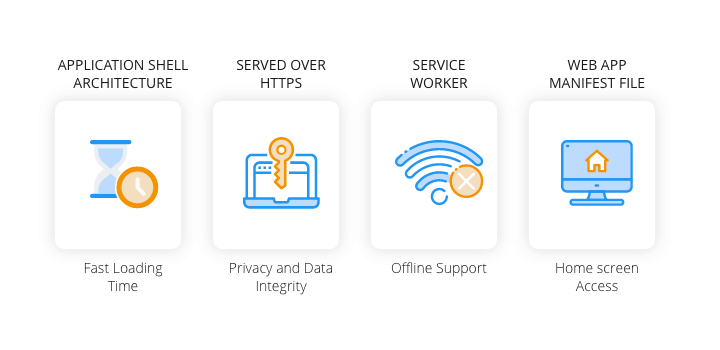
Advantages of Progressive Web Apps (PWA)
- Behave like a native app: Progressive Web Apps behave like native mobile apps in look and feel. Additionally, they provide website-like features such as use of dynamic data and databases.
- Quick and easy installation: PWA can be downloaded directly from the website, after installation PWA gets its own icon just like a mobile app. Also, if you do not want to install it you can directly use it via a url.
- Better control on hardware: PWAs have the advantage of having the access to device’s hardware features such as location, camera, push notifications etc. This enables the developer to create more appealing marketing and engagement channels.
- Available offline: Mobile apps provide the advantage of being available even without internet connectivity. This provides a better user experience and engagement.
Read in detail with examples about PWA here.
With consumer’s needs, technology is evolving at a fast speed. The frontend development is no exception, it is growing at a rapid speed to keep up with the competitive market. These frontend trends for 2022 will help you to stay updated with the latest technology and trends.
Backend Technology Interview Questions
C Programming Language Interview Questions | PHP Interview Questions | .NET Core Interview Questions | NumPy Interview Questions | API Interview Questions | FastAPI Python Web Framework | Java Exception Handling Interview Questions | OOPs Interview Questions and Answers | Java Collections Interview Questions | System Design Interview Questions | Data Structure Concepts | Node.js Interview Questions | Django Interview Questions | React Interview Questions | Microservices Interview Questions | Key Backend Development Skills | Data Science Interview Questions | Python Interview Questions | Java Spring Framework Interview Questions | Spring Boot Interview Questions.
Frontend Technology Interview Questions
HTML Interview Questions | Angular Interview Questions | JavaScript Interview Questions | CSS Interview Questions.
Database Interview Questions
SQL Interview Questions | PostgreSQL Interview Questions | MongoDB Interview Questions | MySQL Interview Questions | DBMS Interview Questions.
Cloud Interview Questions
AWS Lambda Interview Questions | Azure Interview Questions | Cloud Computing Interview Questions | AWS Interview Questions.
Quality Assurance Interview Questions
Moving from Manual Testing to Automated Testing | Selenium Interview Questions | Automation Testing Interview Questions.
DevOps and Cyber Security Interview Questions
DevOps Interview Questions | How to Prevent Cyber Security Attacks | Guide to Ethical Hacking | Network Security Interview Questions.
Design Product Interview Questions
Product Manager Interview Questions | UX Designer Interview Questions.
Interview Preparation Tips
Strength and Weakness Interview Questions | I Accepted a Job Offer But Got Another Interview | Preparation Tips For the Virtual Technical Interview | 7 Tips to Improve Your GitHub Profile to Land a Job | Software Engineer Career Opportunities in Singapore | What can you expect during a whiteboard interview | How To Write A Resignation Letter | Recommendation Letter Templates and Tips.
Quick Links
Practice Skills | Best Tech Recruitment Agency in Singapore, India | Graduate Hiring | HackerTrail Litmus | Scout - Sourcing Top Tech Talent in ONE Minute | About HackerTrail | Careers | Job Openings.





